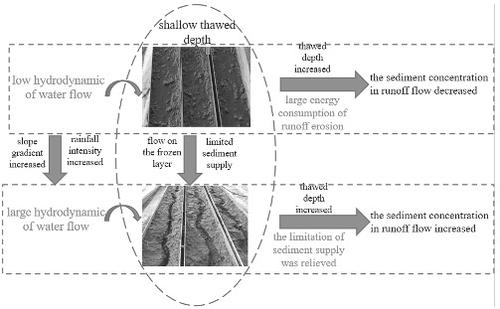当前位置:
X-MOL 学术
›
Earth Surf.Process. Land.
›
论文详情
Our official English website, www.x-mol.net, welcomes your
feedback! (Note: you will need to create a separate account there.)
Influence of thawed soil depth on rainfall erosion of frozen bare meadow soil in the Qinghai–Tibet Plateau
Earth Surface Processes and Landforms ( IF 2.8 ) Pub Date : 2021-04-22 , DOI: 10.1002/esp.5138 Xiaofeng Gao 1 , Xiaonan Shi 1, 2 , Tingwu Lei 1, 3
Earth Surface Processes and Landforms ( IF 2.8 ) Pub Date : 2021-04-22 , DOI: 10.1002/esp.5138 Xiaofeng Gao 1 , Xiaonan Shi 1, 2 , Tingwu Lei 1, 3
Affiliation

|
The Qinghai–Tibet Plateau has a vast area of approximately 70×104 km2 of alpine meadow under the impacts of soil freezing and thawing, thereby inducing intensive water erosion. Quantifying the rainfall erosion process of partially thawed soil provides the basis for model simulation of soil erosion on cold-region hillslopes. In this study, we conducted a laboratory experiment on rainfall-induced erosion of partially thawed soil slope under four slope gradients (5, 10, 15, and 20°), three rainfall intensities (30, 60, and 90 mm h−1), and three thawed soil depths (1, 2, and 10 cm). The results indicated that shallow thawed soil depth aggravated soil erosion of partially thawed soil slopes under low hydrodynamic conditions (rainfall intensity of 30 mm h−1 and slope gradient ≤ 15°), whereas it inhibited erosion under high hydrodynamic conditions (rainfall intensity ≥ 60 mm h−1 or slope gradient > 15°). Soil erosion was controlled by the thawed soil depth and runoff hydrodynamic conditions. When the sediment supply was sufficient, the shallow thawed soil depth had a higher erosion potential and a larger sediment concentration. On the contrary, when the sediment supply was insufficient, the shallow thawed soil depth resulted in lower sediment erosion and a smaller sediment concentration. The hydrodynamic runoff conditions determined whether the sediment supply was sufficient. We propose a model to predict sediment delivery under different slope gradients, rainfall intensities, and thawed soil depths. The model, with a Nash–Sutcliffe efficiency of 0.95, accurately predicted the sediment delivery under different conditions, which was helpful for quantification of the complex feedback of sediment delivery to the factors influencing rainfall erosion of partially thawed soil. This study provides valuable insights into the rainfall erosion mechanism of partially thawed soil slopes in the Qinghai–Tibet Plateau and provides a basis for further studies on soil erosion under different hydrodynamic conditions.
中文翻译:

解冻土壤深度对青藏高原冻土裸露草甸土壤降雨侵蚀的影响
青藏高原在土壤冻融作用下,有约70×10 4 km 2的高寒草甸面积广阔,水土流失严重。量化部分解冻土壤的降雨侵蚀过程,为寒区山坡土壤侵蚀模型模拟提供基础。在本研究中,我们在四种坡度(5°、10°、15°和 20°)、三种降雨强度(30、60 和 90 mm h -1)下对部分解冻的土壤坡度进行了降雨诱发侵蚀的实验室试验。和三个解冻的土壤深度(1、2 和 10 厘米)。结果表明,在低水动力条件下(降雨强度为 30 mm h-1和坡度 ≤ 15°),而它在高水动力条件下抑制侵蚀(降雨强度 ≥ 60 mm h -1或坡度 > 15°)。土壤侵蚀受解冻土壤深度和径流水动力条件控制。当泥沙供应充足时,解冻深度浅的土壤侵蚀潜力更大,泥沙浓度也更大。反之,当泥沙供给不足时,土壤解冻深度浅,泥沙侵蚀量小,含沙量小。水动力径流条件决定了沉积物供应是否充足。我们提出了一个模型来预测不同坡度、降雨强度和解冻土壤深度下的沉积物输送。该模型的纳什-萨特克利夫效率为 0.95,准确预测了不同条件下的沉积物输送,这有助于量化泥沙输送对部分解冻土壤降雨侵蚀影响因素的复杂反馈。该研究为青藏高原部分解冻土坡降雨侵蚀机制提供了有价值的见解,并为进一步研究不同水动力条件下的土壤侵蚀提供了基础。
更新日期:2021-04-22
中文翻译:

解冻土壤深度对青藏高原冻土裸露草甸土壤降雨侵蚀的影响
青藏高原在土壤冻融作用下,有约70×10 4 km 2的高寒草甸面积广阔,水土流失严重。量化部分解冻土壤的降雨侵蚀过程,为寒区山坡土壤侵蚀模型模拟提供基础。在本研究中,我们在四种坡度(5°、10°、15°和 20°)、三种降雨强度(30、60 和 90 mm h -1)下对部分解冻的土壤坡度进行了降雨诱发侵蚀的实验室试验。和三个解冻的土壤深度(1、2 和 10 厘米)。结果表明,在低水动力条件下(降雨强度为 30 mm h-1和坡度 ≤ 15°),而它在高水动力条件下抑制侵蚀(降雨强度 ≥ 60 mm h -1或坡度 > 15°)。土壤侵蚀受解冻土壤深度和径流水动力条件控制。当泥沙供应充足时,解冻深度浅的土壤侵蚀潜力更大,泥沙浓度也更大。反之,当泥沙供给不足时,土壤解冻深度浅,泥沙侵蚀量小,含沙量小。水动力径流条件决定了沉积物供应是否充足。我们提出了一个模型来预测不同坡度、降雨强度和解冻土壤深度下的沉积物输送。该模型的纳什-萨特克利夫效率为 0.95,准确预测了不同条件下的沉积物输送,这有助于量化泥沙输送对部分解冻土壤降雨侵蚀影响因素的复杂反馈。该研究为青藏高原部分解冻土坡降雨侵蚀机制提供了有价值的见解,并为进一步研究不同水动力条件下的土壤侵蚀提供了基础。











































 京公网安备 11010802027423号
京公网安备 11010802027423号